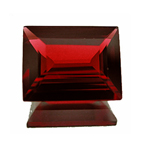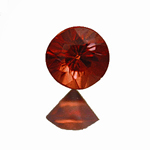Pyrope Garnet
For centuries Pyrope was the most popular and widespread of all Garnets. Today Pyrope has greatly lost in appreciation. The reasons are manifold:Most Pyropes are of rather dark tone. Other red Garnets, Rhodolites (of the Pyrope-Almandine series) in particular, are of lighter, more friendly and attractive tone and appear much more vivid when set in jewellery.
Pyrope had its peak popularity in Victorian Age, when the industrial revolution led to mass production of jewellery in England. Nowadays Pyrope has a reputation of being old-fashioned.
Pyropes mostly are rather small. A few specimens of spectacular size can be found in European treasure chambers. De Boodt mentions a Pyrope the size of a pigeon's egg in the possession of the Habsburg Emperor Rudolph and the Green Vault in Dresden, Germany, houses a Pyrope of more than 468cts, but these stones are truly exceptional and extremely rare. The biggest part of all Pyropes found is below 1ct. In the Bohemian mines only one stone out of two tonnes (!) of Pyrope surpassed the weight of 5cts. To find one stone of 2.5cts, you still had to mine 500kgs.
With the discovery of ever new, more attractive red Garnets, particularly in India and Africa, Pyrope value quickly and dramatically decreased and prestige faded. At the end of the 19th century a good 1ct Pyrope fetched 150 US Dollars (value-adjusted). Today the same stone can be found for a few Euros only.
Origin of name: crudely translates into "fiery eyed", from greek πῦρ pyr = fire and ὸπτομαι optomai = I see
Can be confused with: other red gemstones (other Garnets, Spinel, Tourmaline)
Localities: Pyrope is quite widespread. Mindat.org lists 256 localities. The most important sources are Bohemia, near Carlsbad, Czech Republik, South Africa and the USA.
Pyrope deposits of less commercial importance are in Russia, Australia, Sri Lanka and China, as well as Austria, Scotland, Norway and Germany.

Unusually bright and large Pyrope (3.42cts) of unknown origin

Orange-red Pyrope from India
History: Bohemian Garnets are amongst the oldest known Garnets and were found in Bronze Age graves near the mining areas. The first reference to regular mining activities was given by Agricola in 1546. The mine was located a few kilometers from Litoměřice, near Carlsbad.
The first boom started, when the opening of the Carlsbad and the Teplice spas gave the region a boost in tourism. Bohemian Garnet jewellery was a popular souvenir and became famous all over Europe fast.
The second boom came with the industrial revolution which led to jewellery mass production. By the end of the 18th century a flourishing industry, comprising everything from mining to cutting to jewellery production, had developed. In the Carlsbad-Teplice-Prague triangle no less than seventeen villages and small towns were known as centers for mining, cutting and jewellery making. More than ten thousand people were working in the trade.
The beginning of th 20th century brought dramatic changes. Victorian jewellery went out of fashion and newly discovered Pyrope occurrences in South Africa, the USA and many more countries produced stones of a lighte, more attractive tone.
South African Pyropes, a by-product of diamond mining, in particular were far superior to Bohemian Pyropes. Not only were they of better colour – which earned them the trade name "Cape Ruby" – they were also found in larger sizes. So it was these stones, that heralded the decline of the Bohemian Garnet industry.
Moreover the Pyrope discoveries in the USA, at first in the eastern states of Massachusetts, New Hampshire, Georgia and North Carolina, later also in Arizona, led to the loss of the American market and contributed to the fact that Bohemian Garnet jewellery no longer plays a major part in world jewellery production.
Handling: somewhat sensitive to heat and acids but basically unproblematic
Gemmological Properties of Pyrope Garnet
Formula:
Mg3Al2[SiO4]3
Crystal system:
cubic
Mohs hardness:
7.5
Specific gravity:
3.65 to 3.84
Refractive index:
variable 1.73 to 1.75
Dispersion:
0.022
Pleochroism:
none
Luminiscence:
inert
Lustre:
vitreous
Cleavage:
none
Fracture:
conchoidal
Colour:
orange-red, brownish red, purplish red, mostly dark tone
 Deutsch
Deutsch